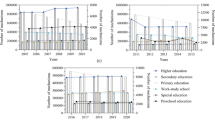Abstract
This paper tracks the progression of knowledge levels in the labor force between 1975 and 1985 in the Japanese economy as a whole and it's fifty three component sectors, utilizing a measure of knowledge which reflects the worker's educational level and vocational preparation, verbal, numerical and analytical capability and his/her ability to synthesize inferences and knowledge. The links between the worker's knowledge levels and the economic fortunes of industries are inferred for various sectors particularly those with divergent patterns of comparative advantage. Changes in the levels of knowledge embodied in all workers in the different industries are decomposed into their sources: technical change, changes in the structure of final demand, changes in labor productivity, and the changes in the component structure of occupation. The analysis of these sources highlights the facilitating role of human capital changes in Japan in an era of considerable structural change.
Similar content being viewed by others
References
Baumol W (1967) The micro economics of unbalanced growth. Am Econ Rev 57:415–426
Balassa B (1965) Trade liberalization and “revealed” comparative advantage. Manchester School 33:99–123
Balassa B, Noland M (1986) Japan in the World Economy. Institute for International Economics, Washington, DC
Carter A (1970) Structural change in the American economy. Harvard University Press, Cambridge, MA
Economic Planning Agency, Government of Japan (1990) Economic Survey of Japan 1989–1990
Economic Planning Agency, Government of Japan (1986) Economic Survey of Japan 1985–1986
Forssel O (1990) Growth and changes in the structure of the finnish economy in the 1960s and 1970s, chap 18, pp 287–302
Kanemitsu H, Ohnishi M (1989) An input output analysis of technological changes in the Japanese economy 1970–1980. In: Miller RE, Polenske K, Rose A (eds) Frontiers of input output analysis. Oxford University Press, New York, pp 308–333
Komatsuzaka S, Tanimitsu T, Ohira G, Yamamoto K (undated) An analysis of information economy in Japan from 1960 to 1980. Monograph published by the Research Institute of Telecommunication and Economics, Tokyo
Lakshmanan TR (1989) Technological and institutional innovations in the service sector. In: Andersson A, Batten D, Karlsson C (eds) Knowledge and industrial organization. Springer, Berlin Heidelberg New York, pp 63–79
Lakshmanan TR, Han X, Liang Y (1991) The nature and composition of economic change in the core and peripheral regions of Japan 1975–1985. A paper presented at the North American Regional Science Congress New Orleans
Lakshmanan TR, Che Y (1992) The economic-environmental evolution of major industrialized societies. Boston University Center for Energy and Environmental Studies
Machlup F (1962) The production and distribution of knowledge in the United States. Princeton University Press, Princeton
Machlup F (1984) The economics of information and human capital: the third volume of knowledge: its creation, distribution and economic significance. Princeton University Press, Princeton
Miller AR, Treiman DJ, Cain PS, Roos PA (1980) Work, jobs and occupations. National Academy Press, Washington, DC
Nakamura T (1981) The postwar Japanese economy: its development and structure. Tokyo University Press, Tokyo
OECD (Organization for Economic Cooperation and Development) (1981) Information activities, electronics and telecommunications activities: impact on employment, growth and trade, Paris
Porat MU, Rubin MR (1977) The information economy, 9 volumes. Government Printing Office, Washington, DC
Roos PA, Treiman DJ (1980) Appendix F. DOT scales for the 1970 census classification. In: Miller AR, Treiman DJ, Cain PS, Roos PA (eds) Work jobs and occupations. National Academy Press, Washington, DC, pp 336–389
Rubin MR, Huber MT (1986) The knowledge industry in the United States 1960–1980. Princeton University Press, Princeton
Skolka J (1989) Input-output structural decomposition analysis for Austria. Policy Modeling 2(i):45–66
Urate S (1990) Economic growth and structural change in the Soviet economy, 1959–1972
Uno K (1987) Japanese industrial performance. North-Holland, New York
Author information
Authors and Affiliations
Rights and permissions
About this article
Cite this article
Lakshmanan, T.R., Han, X. & Liang, Y. The evolution of knowledge in the labor force during industrial structuring in Japan. Ann Reg Sci 27, 41–60 (1993). https://doi.org/10.1007/BF01581832
Issue Date:
DOI: https://doi.org/10.1007/BF01581832




